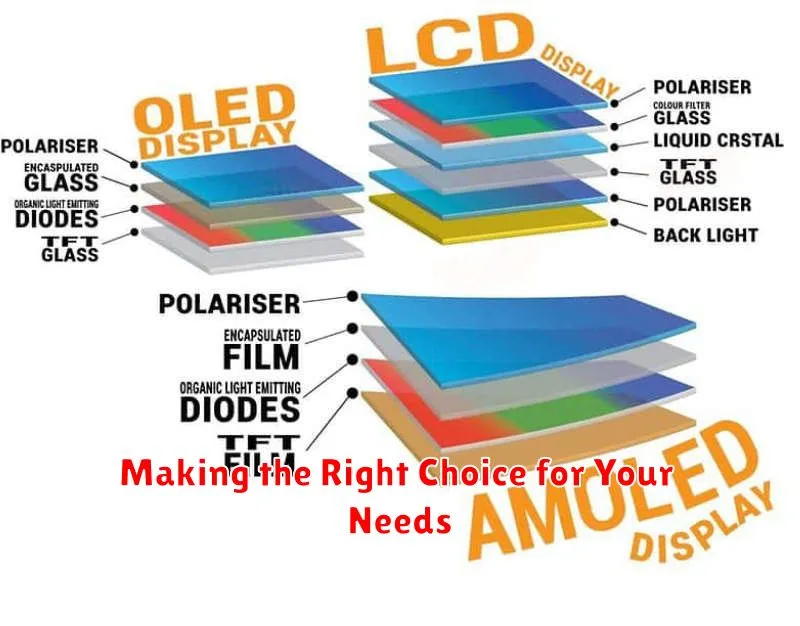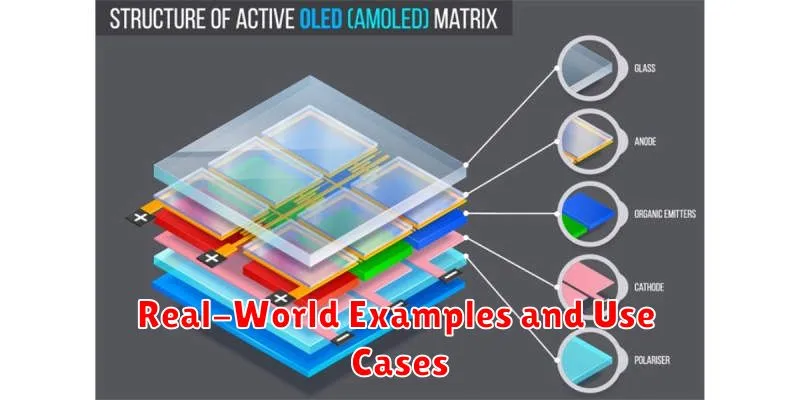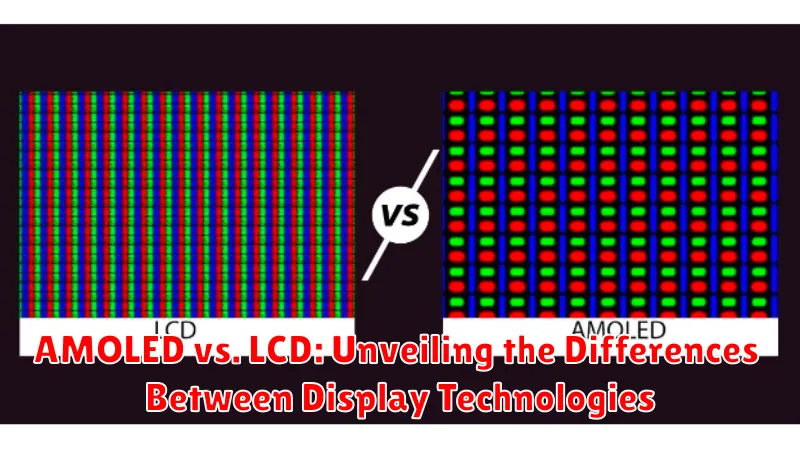In the ever-evolving world of display technology, two prominent contenders consistently vie for dominance: AMOLED (Active-Matrix Organic Light-Emitting Diode) and LCD (Liquid Crystal Display). Understanding the core differences between these two display technologies is crucial for making informed decisions when purchasing smartphones, televisions, monitors, and other devices that incorporate these screens. This article will delve into an in-depth comparison of AMOLED vs. LCD, exploring their respective strengths and weaknesses across various key metrics, including contrast ratio, color accuracy, power consumption, response times, and overall viewing experience. By unveiling the differences between these competing technologies, you will be empowered to choose the display that best suits your individual needs and preferences.
The ongoing debate surrounding AMOLED vs. LCD often centers around the inherent trade-offs associated with each technology. AMOLED displays are lauded for their superior black levels, vibrant colors, and energy efficiency, while LCD screens are often favored for their affordability and brightness. This article will dissect the underlying mechanisms that contribute to these distinguishing characteristics, enabling you to weigh the differences between AMOLED and LCD in a comprehensive and objective manner. From pixel structure and backlighting techniques to color reproduction and refresh rates, we will explore the nuances of each technology, ultimately assisting you in navigating the complex landscape of modern displays and making an educated decision on which display technology reigns supreme for your particular use case.
Understanding Display Technology Basics
Displays are the visual gateway to our digital devices, translating complex data into understandable images and text. They employ various technologies, but all share the fundamental goal of illuminating pixels to create the images we see.
A pixel, short for “picture element,” is the smallest unit of a digital image. Each pixel’s color and brightness contribute to the overall picture. These pixels are arranged in a grid, and the density of these pixels, measured in pixels per inch (PPI), determines the display’s sharpness.
Display technologies primarily differ in how they illuminate these pixels. Some rely on a separate backlight, while others have self-illuminating pixels. This core distinction leads to variations in color reproduction, contrast, power consumption, and other crucial aspects of the viewing experience.
Deep Dive into AMOLED Technology
AMOLED (Active-Matrix Organic Light-Emitting Diode) is a display technology known for its vibrant colors and deep blacks. It utilizes organic compounds that light up individually when an electric current is applied.
Unlike LCDs that require a backlight, each AMOLED pixel emits its own light. This self-emissive property allows for true blacks by simply turning off the necessary pixels. Consequently, AMOLED displays offer superior contrast ratios and wider viewing angles.
AMOLED displays are characterized by their thin and flexible nature, making them suitable for curved screens and foldable devices. The individual pixel control also contributes to lower power consumption, especially when displaying darker content.
Structure of an AMOLED Display
A typical AMOLED display consists of several layers, including a thin-film transistor (TFT) array, an organic emissive layer, and a substrate. The TFT acts as a switch, controlling the flow of current to each individual pixel. The organic layer contains the light-emitting materials.
Exploring LCD Technology
Liquid Crystal Display (LCD) technology relies on liquid crystals sandwiched between two polarized glass panels. These crystals don’t produce light themselves. Instead, a backlight illuminates the crystals.
Backlights are a crucial component of LCDs. Traditional LCDs used Cold Cathode Fluorescent Lamps (CCFL) backlights. However, modern LCDs often utilize LED backlights, which offer improved energy efficiency and color reproduction. These LED backlights can be arranged in different configurations, such as edge-lit or full-array local dimming, impacting contrast and black levels.
The liquid crystals act as shutters, controlling the passage of light from the backlight. By applying an electric field, the orientation of the crystals changes, regulating the amount of light that passes through to create the image. Color filters are used to generate the different colors displayed on the screen.
Comparing AMOLED and LCD: Key Differences
Several key distinctions separate AMOLED and LCD technologies. A core difference lies in how they produce light. AMOLED pixels emit their own light, while LCD pixels rely on a backlight for illumination.
This fundamental difference leads to variations in black levels. AMOLED displays can achieve true black by simply turning off individual pixels, resulting in infinite contrast ratios. LCDs, even with advanced backlighting techniques, struggle to produce true black due to backlight bleed, leading to lower contrast ratios.
Color reproduction also varies. AMOLED typically offers more vibrant and saturated colors, while LCDs can provide more accurate color representation, particularly in higher-end models. Viewing angles are generally wider on AMOLED displays, with less color shifting compared to some LCD types.
Power consumption differs based on content displayed. AMOLED is more power-efficient when displaying dark content, as individual pixels can be turned off. Conversely, LCDs can be more efficient when displaying predominantly bright content.
| Feature | AMOLED | LCD |
|---|---|---|
| Black Levels | True Black | Dark Gray |
| Contrast Ratio | Infinite | Limited |
| Color Saturation | High | Moderate |
Pros and Cons of Each Display Type
AMOLED
Pros: AMOLED displays offer true blacks due to individual pixel illumination, resulting in infinite contrast ratio and vibrant colors. They are also more power-efficient when displaying dark content and have wider viewing angles. AMOLEDs boast faster response times, leading to smoother motion.
Cons: AMOLED displays can suffer from burn-in with static elements displayed for extended periods. Their peak brightness can be lower than some LCDs, potentially impacting outdoor visibility. The manufacturing process can be more complex, leading to higher production costs.
LCD
Pros: LCDs generally achieve higher peak brightness than AMOLEDs, improving visibility in bright environments. They are less susceptible to burn-in and typically have longer lifespans. Production costs are often lower, leading to more affordable devices.
Cons: LCDs rely on backlights, which can result in less accurate blacks and lower contrast ratios compared to AMOLEDs. Viewing angles can be more limited, and they are generally less power-efficient than AMOLEDs when displaying dark content. Response times are generally slower than AMOLED.
Making the Right Choice for Your Needs

Selecting between AMOLED and LCD depends heavily on individual priorities and use cases. Consider these factors to make an informed decision:
Budget
LCDs generally offer a more budget-friendly option. If cost is a primary concern, LCDs are often the more accessible choice.
Power Consumption
If battery life is paramount, AMOLED’s ability to selectively illuminate pixels translates to significant power savings, especially with dark-themed content.
Image Quality
For users prioritizing vibrant colors, deep blacks, and high contrast, AMOLED offers a superior visual experience. However, some may find AMOLED colors oversaturated, where LCD offers more natural color reproduction.
Ambient Light Visibility
LCDs often perform better in bright sunlight due to their higher peak brightness. AMOLED screens, while improving, can sometimes struggle in direct sunlight.
Longevity
LCD technology is generally considered more resistant to burn-in, a phenomenon where persistent images leave faint ghosting on the screen. While modern AMOLEDs have mitigated burn-in, it remains a slight risk.
Real-World Examples and Use Cases

Understanding the core differences between AMOLED and LCD allows us to see why certain display technologies are favored in specific applications. Consider smartphones. Many flagship models utilize AMOLED for its vibrant colors and deep blacks, creating an immersive experience for media consumption and gaming.
Smartwatches also frequently employ AMOLED. The always-on display functionality benefits from AMOLED’s ability to illuminate only necessary pixels, conserving battery life. In contrast, LCDs typically require a backlight for the entire display, even if only showing the time.
Televisions and computer monitors present a different landscape. While AMOLED is present in the high-end television market, LCD, particularly with LED backlighting enhancements, remains popular due to factors like brightness and cost-effectiveness for larger screen sizes.
The Future of Display Technology
The display technology landscape is in constant evolution. Beyond the current AMOLED and LCD rivalry, several emerging technologies promise to reshape how we interact with visual information.
MicroLED displays offer the potential for incredibly high brightness, improved color accuracy, and increased energy efficiency compared to existing technologies. While currently facing manufacturing challenges, MicroLEDs are poised to become a significant player in the future, particularly in high-end displays.
Quantum Dot OLED (QD-OLED) combines the benefits of quantum dot color enhancement with the self-emissive properties of OLED technology. This hybrid approach offers the potential for improved color gamut and brightness, pushing the boundaries of image quality.
Furthermore, advancements in flexible and foldable displays are opening up exciting new possibilities for device design. These technologies, often based on OLED materials due to their inherent flexibility, allow for curved screens, foldable phones, and other innovative form factors.
Research into technologies like printed electronics and rollable displays suggests that the future of displays will be even more dynamic and adaptable to our needs.

